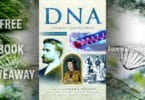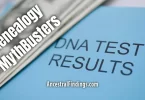DNA is an important part of genealogy research these days. It can help confirm relationships, help you find new living relatives who may have the information you don’t have (and are willing to share), and can help you discover new avenues of research for tough-to-trace family lines. If you haven’t yet explored DNA in your genealogy research, it’s time you did. Here is everything you need to know about DNA research in genealogy to get you started, including the different types and what it can help you find.
DNA Research: The Keys to the Genealogy Kingdom
Your DNA tells a lot about you. It lets you know what health conditions you are and are not susceptible to, determines the color of your eyes and hair, your ability to learn certain things easily (like math), and even your ability to smell or taste certain things. It also tells you about your ancestors, since they are the ones who passed down their DNA to you.
You have a 50% chance of inheriting any particular DNA trait from either parent. This means that if one parent carries the DNA for brown eyes and one carries the DNA for blue eyes, you have a 50% chance of inheriting either one. If you just happened to get the blue eye DNA and your sister got the brown eye DNA, that just means the genetic coin flip landed on one side for you and one side for her.
Your parents likewise each had a 50% chance of inheriting different types of DNA from each of their parents. Whatever they inherited, they have a 50% chance of handing down to you. This is how physical features and other family traits change (or sometimes stay the same) through the generations.
Your genes are located in your DNA. The more genes you share with someone, the closer you are related to them. If you aren’t sure of your relationship to someone, a DNA test done by both of you will tell you how you’re related. For example, full siblings share around 50% of their genes. Half-siblings share only about 25%. You also share about 25% with your aunts and uncles. First cousins share around 12%, second cousins share around 3%, and so on down the ancestral line.
However, relationships to living relatives are not all DNA research can reveal. It all depends on what type of DNA you have tested.
There are three types of DNA that are tested by the genealogical DNA testing companies:
YDNA: This type of DNA is only passed down from father to son. It goes in a direct male line from you (or your closest male ancestor) all the way down your male line deep into the past. It is often used in surname studies to prove relationships between people of the same surname who suspect they may share a common ancestor. It is an excellent tool to use if you are having trouble tracing your male line. Companies that test YDNA can match you with those who most closely share your particular YDNA sequence, and you can reach out to those people to see just where your family lines converge. It can answer a lot of male line ancestry questions.
mtDNA: This type of DNA is only passed down from mother to daughter. Sons inherit it, too (unlike YDNA, which daughters do not inherit), but cannot pass it on to their offspring. Only daughters can do that. Both men and women can use it to answer questions regarding their maternal line, similarly to the way YDNA is used to answer male line genealogy questions.
Autosomal DNA: This is often referred to as “junk” DNA, as it doesn’t seem to do anything specific in humans. It does, however, leave an ancestral trail to all branches of your family. Because of this, it is beginning to become the main type of DNA that DNA testing companies are using. It gives you a far broader picture of your family tree than YDNA or mtDNA. Autosomal DNA can match you with genetic relatives from either side of your family. To know which side, you’ll need to have at least one parent get tested, too.
You can reach out to these genetic relatives through the DNA company testing sites, and work out your common ancestors together, which often solves many genealogical mysteries. If you have a mystery you want to work on, you can even get people you know or suspect are related on your mystery line to test, and the autosomal results will tell you whether you all share a common ancestor or not. If you do, you can continue looking for more people to take the test until you’ve gathered enough family history information from known genetic relatives to determine the common ancestor and solve the mystery.
Companies Currently Doing Genealogical DNA Testing (and It’s More Affordable Than Ever!)
There are currently several companies doing DNA testing for genealogical purposes. It is much more affordable now than when it was new on the market a decade ago and still a novelty. Most anyone can afford it now. Many companies charge less than the major genealogical research sites charge for annual memberships. Some companies with good reputations you might want to consider include:
If you haven’t used DNA to explore your genealogy, you should. It is a wonderful adjunct to the traditional research methods you’re using. Even better, it has the potential to unlock genealogical mysteries when the paper trail ends. Use it, and discover your true roots.






